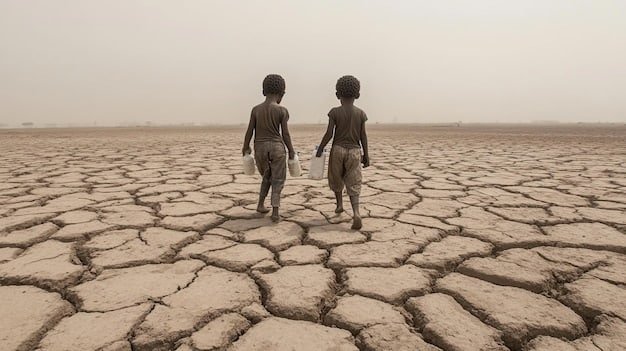Financial Planning for Climate Migration: Costs & Strategies

Financial planning for climate migration involves strategically preparing for the financial burdens of relocating due to climate change, encompassing aspects like budgeting, property sales, and identifying affordable, resilient communities.
Financial Planning for Climate Migration: Preparing for Relocation Costs
As climate change intensifies, the prospect of relocating due to its effects is becoming a reality for many. Financial planning for climate migration is a crucial step in preparing for the significant costs and adjustments associated with moving to a more sustainable and safer environment. This involves understanding the financial implications, creating a robust plan, and making informed decisions to secure your future.
Understanding the Financial Impact of Climate Migration
Climate migration isn’t just about moving from one place to another; it’s a financial undertaking that requires careful consideration. The costs can range from immediate moving expenses to long-term adjustments in living standards. Understanding these financial impacts is the first step in creating a comprehensive financial plan.
Immediate Relocation Costs
The initial costs of relocating can be substantial. These include transportation, temporary housing, and the logistical expenses of moving your belongings. Proper budgeting and resource allocation can help mitigate financial strain during this transition.
Long-Term Financial Adjustments
Beyond the immediate expenses, climate migration can lead to long-term financial adjustments. These might include changes in job markets, cost of living, and property values in the new location. Planning for these adjustments is crucial for sustainable financial health.
- Property Values: Understand how climate risks impact property values in both your current and potential locations.
- Cost of Living: Research and budget for the cost of living in your new community, including housing, food, and transportation.
- Job Market: Assess the job market in your new location and identify opportunities that match your skills and experience.
Understanding the financial implications, both immediate and long-term, is crucial for successful climate migration. This knowledge allows you to create a realistic and effective financial plan.
Assessing Your Current Financial Situation
Before diving into the specifics of climate migration, it’s essential to assess your current financial situation. This involves taking stock of your assets, debts, income, and expenses. A clear understanding of your financial standing will inform your planning process and help you make realistic decisions.
Creating a Detailed Financial Inventory
Start by creating a comprehensive list of all your assets, including savings, investments, real estate, and personal property. Similarly, list all your debts, such as mortgages, loans, and credit card balances. This inventory provides a clear picture of your net worth.
Analyzing Income and Expenses
Review your income sources and monthly expenses. Identify areas where you can reduce spending or increase income. This analysis will help you understand your cash flow and identify opportunities to save for relocation costs. It’s especially crucial to determine how much you can realistically save each month.
- Track Expenses: Use budgeting apps or spreadsheets to monitor your spending habits and identify areas for improvement.
- Reduce Debt: Develop a plan to pay down high-interest debt, such as credit card balances, to free up more cash flow.
- Increase Savings: Set specific savings goals and automate contributions to a dedicated relocation fund.
By thoroughly assessing your current financial situation, you can develop a solid foundation for your climate migration financial plan. This ensures you have a clear understanding of your resources and limitations.

Developing a Climate Migration Budget
Creating a dedicated budget for climate migration is essential to ensure you have sufficient funds to cover the relocation costs. This budget should include both upfront expenses and ongoing costs in your new location. A well-thought-out budget will help you stay on track and avoid unexpected financial setbacks.
Estimating Relocation Expenses
Start by estimating the costs associated with moving, such as transportation, packing services, and temporary housing. Also, consider the costs of setting up a new household, including furniture, appliances, and utilities. Researching these expenses in advance will provide a realistic estimate of your upfront costs.
Projecting Ongoing Living Expenses
In addition to the immediate relocation expenses, you need to project your ongoing living expenses in the new location. This includes housing, food, healthcare, and transportation. Research the cost of living in your target community to ensure you can afford to maintain a comfortable lifestyle.
- Housing Costs: Research rental or purchase prices, property taxes, and insurance rates in your new location.
- Healthcare: Understand the healthcare system in your new community and budget for insurance premiums and medical expenses.
- Transportation: Evaluate transportation options and budget for vehicle costs, public transportation fares, or commuting expenses.
Developing a detailed climate migration budget will help you stay organized and financially prepared for the relocation process. By anticipating and planning for these expenses, you can reduce the financial stress associated with climate migration.
Selling or Renting Your Current Property
One of the most significant financial considerations in climate migration is what to do with your current property. Deciding whether to sell or rent your home can have a substantial impact on your overall financial plan. Evaluate the pros and cons of each option carefully before making a decision.
Evaluating the Local Real Estate Market
Before making a decision, assess the local real estate market in your current location. Climate change can affect property values, so it’s essential to understand the risks and potential returns. Consider factors such as flood zones, wildfire risks, and sea-level rise projections.
Weighing the Pros and Cons of Selling
Selling your property can provide a lump sum of cash to fund your relocation. However, it also means giving up potential future income and investment. Weigh the benefits of immediate capital against the potential long-term gains of ownership.
Considering the Option of Renting
Renting your property can provide a steady stream of income while you relocate. However, it also involves managing tenants, dealing with maintenance issues, and potentially facing periods of vacancy. Assess your ability to manage these responsibilities effectively.

Deciding whether to sell or rent your current property requires careful evaluation of market conditions, financial goals, and personal preferences. This decision will significantly impact your climate migration financial plan.
Finding Affordable and Resilient Communities
Relocating due to climate change involves more than just financial planning; it requires identifying communities that are both affordable and resilient to climate impacts. Researching potential destinations and evaluating their long-term sustainability is crucial for a successful transition.
Researching Climate Resilient Locations
Identify communities that are less vulnerable to climate change impacts such as flooding, wildfires, and extreme heat. Utilize resources like government reports, scientific studies, and local assessments to evaluate the climate resilience of potential locations.
Evaluating Affordability and Cost of Living
While climate resilience is essential, so is affordability. Research the cost of living in potential communities, including housing, healthcare, and transportation. Look for areas that offer a balance between climate safety and financial accessibility.
- Consider Smaller Towns: Explore smaller towns and rural areas that may offer lower housing costs and a more resilient environment.
- Evaluate Government Incentives: Research government programs and incentives that support climate migration and help with relocation costs.
- Network with Local Communities: Connect with residents in potential locations to gain insights into local conditions and financial considerations.
Finding affordable and resilient communities requires thorough research and careful consideration. By balancing climate safety with financial accessibility, you can create a sustainable and secure future for yourself and your family.
Managing Financial Risks During and After Relocation
Climate migration presents various financial risks that need to be managed both during and after the relocation process. These risks can range from property damage and job loss to unexpected expenses and financial scams. Developing strategies to mitigate these risks is essential for financial stability.
Insurance Coverage and Disaster Preparedness
Ensure you have adequate insurance coverage for your property, health, and personal belongings. Evaluate the potential risks in your new location, such as flooding or wildfires, and adjust your insurance policies accordingly. Develop a disaster preparedness plan to protect your assets and minimize financial losses.
Job Security and Income Stability
Assess the job market in your new location and secure employment before relocating, if possible. Maintain a diversified income stream and explore opportunities for remote work or entrepreneurship. Build an emergency fund to cover unexpected expenses and periods of unemployment.
Managing financial risks requires proactive planning and continuous monitoring. By taking steps to protect your assets and income, you can mitigate the financial challenges associated with climate migration.
| Key Point | Brief Description |
|---|---|
| 💰 Budgeting | Create a detailed budget for relocation costs and new living expenses. |
| 🏘️ Property | Decide whether to sell or rent your current property based on market conditions. |
| 📍 Location | Find affordable and climate-resilient communities for relocation. |
| 🛡️ Risk | Manage financial risks through insurance and emergency savings. |
Frequently Asked Questions
▼
▼
▼
▼
▼
Conclusion
Planning for climate migration requires a comprehensive understanding of its financial implications and proactive strategies to mitigate risks. By assessing your current financial situation, developing a detailed budget, and researching resilient communities, you can navigate the challenges of relocation and secure a sustainable future. Remember, informed decisions and careful planning are key to a successful climate migration journey.





